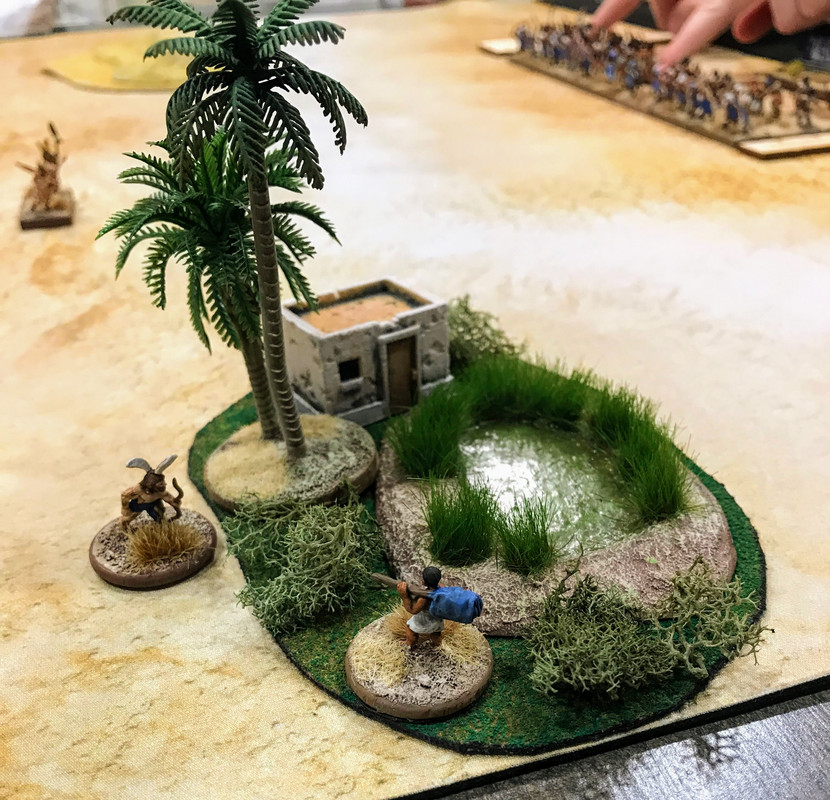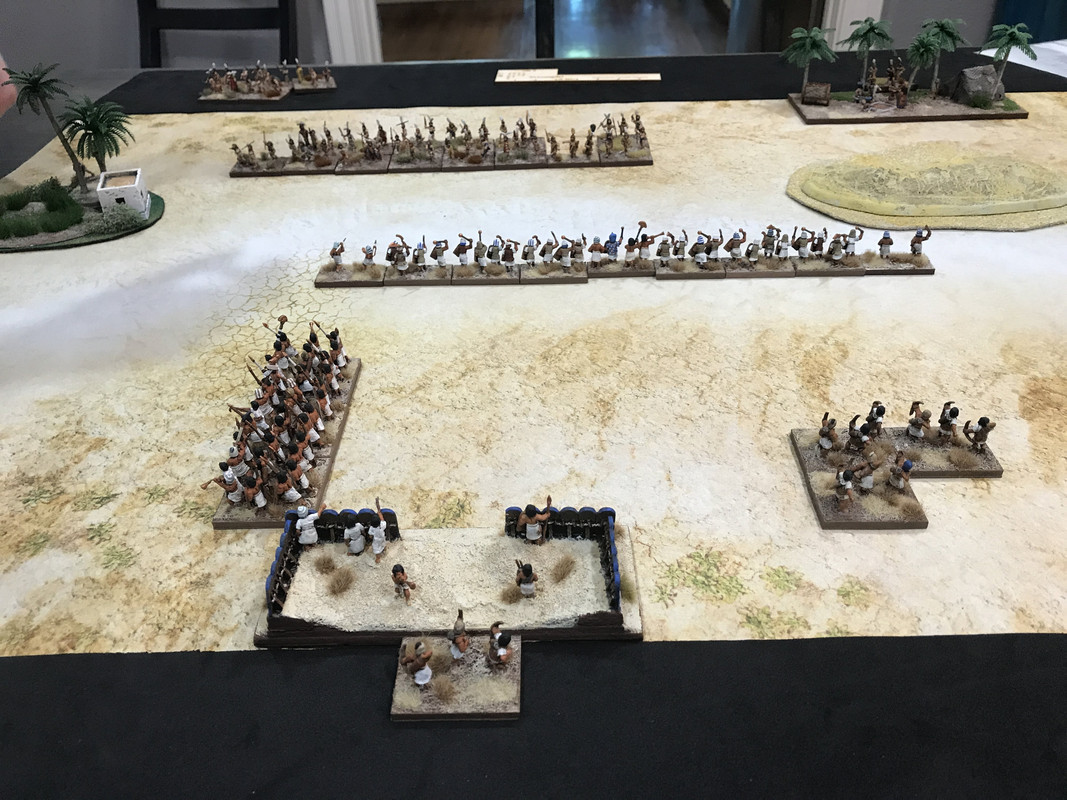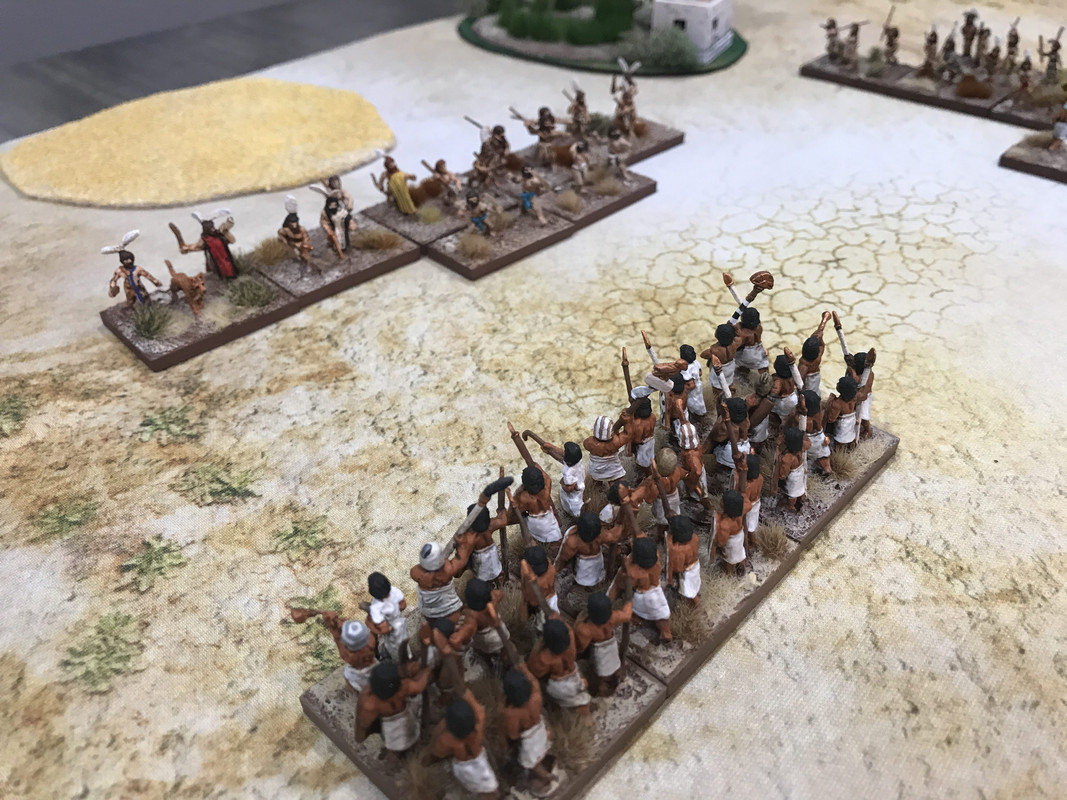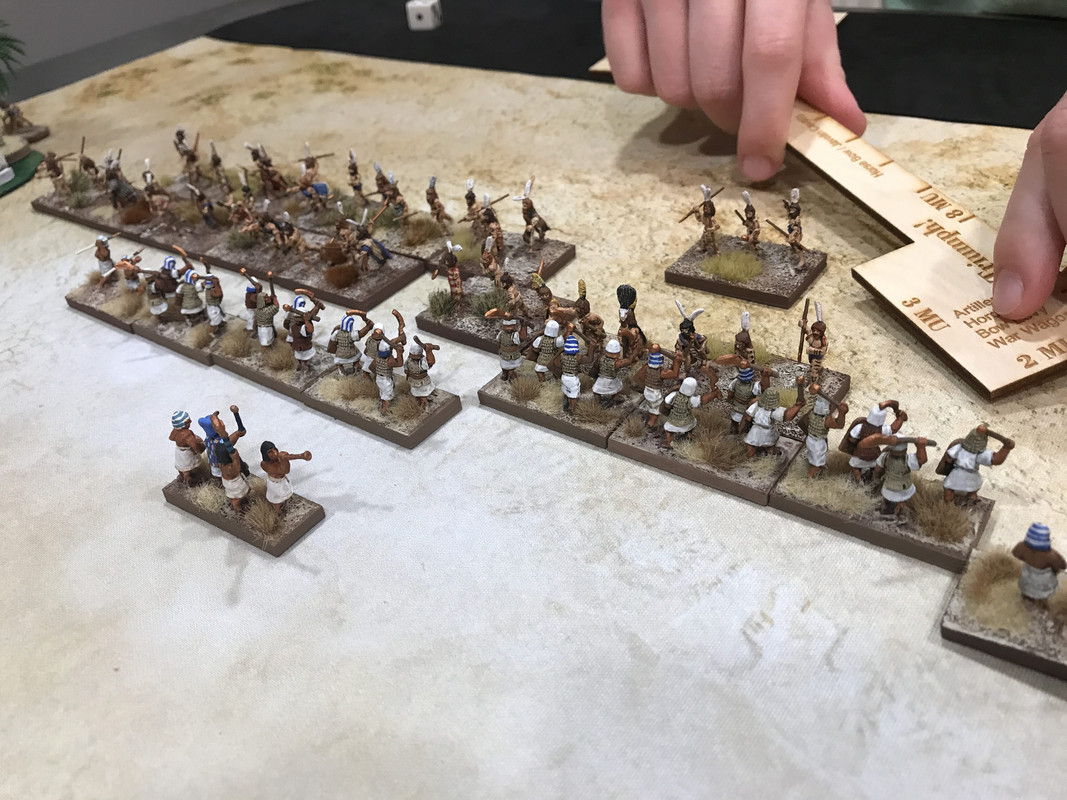Libyans vs. Egyptians, 2200 BC
Posted: Tue May 11, 2021 5:10 pm
My son and I played two battles of Triumph! This week using the Ancient Libyans and the Early Egyptians. The setting was 2200 BC, the time of Neferkare of the 6th Dynasty towards the end of the Old Kingdom.
The Libyan forces were nineteen Rabble tribesmen, with two Skirmishers and a Warband general. They also had the Pack Trains battle card. I commanded the Libyans.
The Egyptian forces were an Elite infantry general (in this case the Pharaoh himself wearing the blue war crown), six units of menfat Raiders, three Hordes of local troops, four Bow levy, and two Skirmishers. My son commanded the Egyptians.

The Battlefield.
The terrain was Dry with three features - a Dune, some Rough, and an Oasis. These were all towards the edges of the board and played little role in the battle.

Deployment.
The Libyans had the option for a flank march, which would consist of eight stands of Rabble. The rest of the Libyan troops set up in a deep mass in the center. The Libyan plan was to try for the Egyptian camp with the flank march while avoiding defeat in the center.
The Egyptian plan was to strike the Libyan main body with the Raiders and Horde. Skirmishers would be sent to raid the Libyan camp. The Bow Levy would hold off the flank march.

Opening Moves.
The Egyptians moved first and the Skirmishers moved rapidly towards the dune in front of the Libyan camp. The main body advanced slowly to keep pace with the mass of conscripts attached behind their right flank.
This presented a dilemma for the Libyans. Should the flank march continue as planned, or come in near the Libyan camp to counter the Skirmishers? The Libyans decided to continue with the plan, counting on the fact the Egyptian Skirmishers were going to be far from the main battle where the Egyptians would be fully engaged.
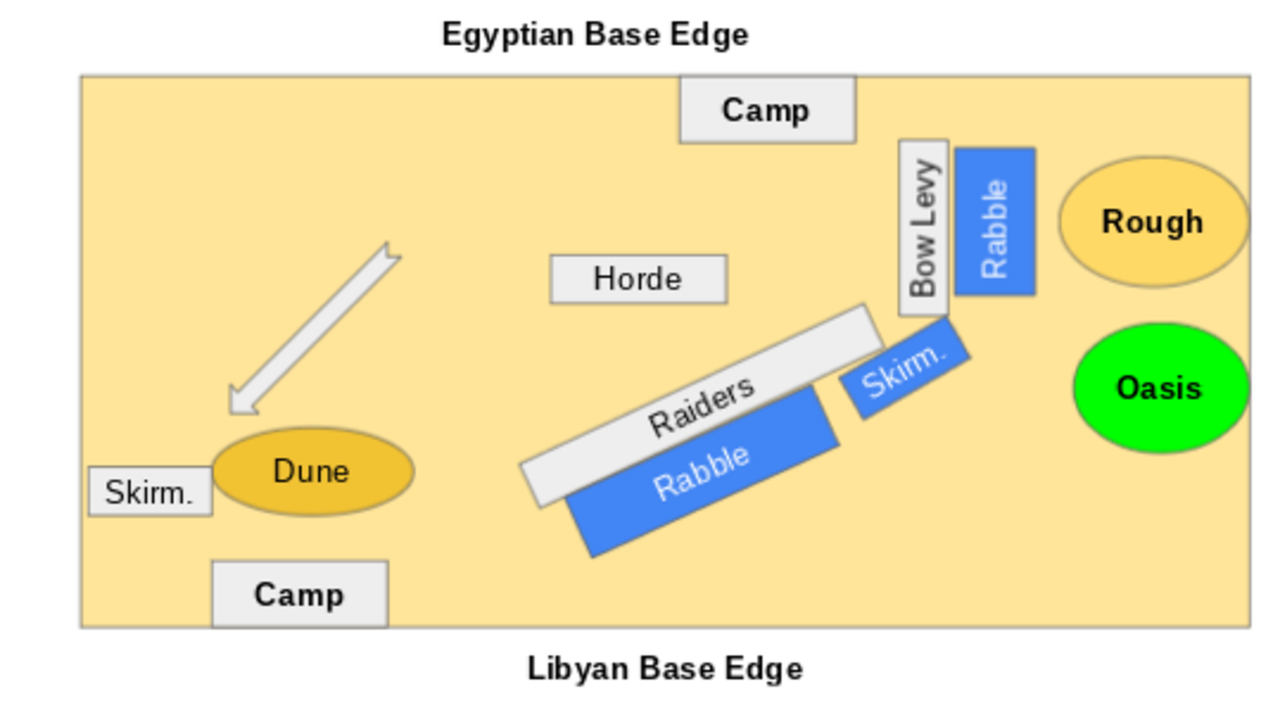
The Battle.
The Egyptian Raiders continued to advance steadily, still hampered by the slow-moving Horde. The Libyan flank march was the main effort and moved quickly. Most of Pharaoh’s focus (command points) was on moving the Bow Levy and some Raiders to counter the flanking Libyans. The Egyptian Skirmishers therefore faltered in their mission, far from Pharaoh’s eye.
The Libyan flank march destroyed the Egyptian Bow levy (and the stand of Raiders sent to support them) then turned their attention to the camp.
The Libyan main body slowly wheeled, bringing their right flank closer to their flank marchers. The Libyan skirmishers went forward to support them by drawing off some of the enemy standing in their way.
Meanwhile, the Raiders abandoned the Horde and moved forward rapidly. The Raiders, along with the Pharaoh (Elite Foot General), made contact with the Libyan main body and began scattering the tribesmen.
The Horde played no further part in the battle.
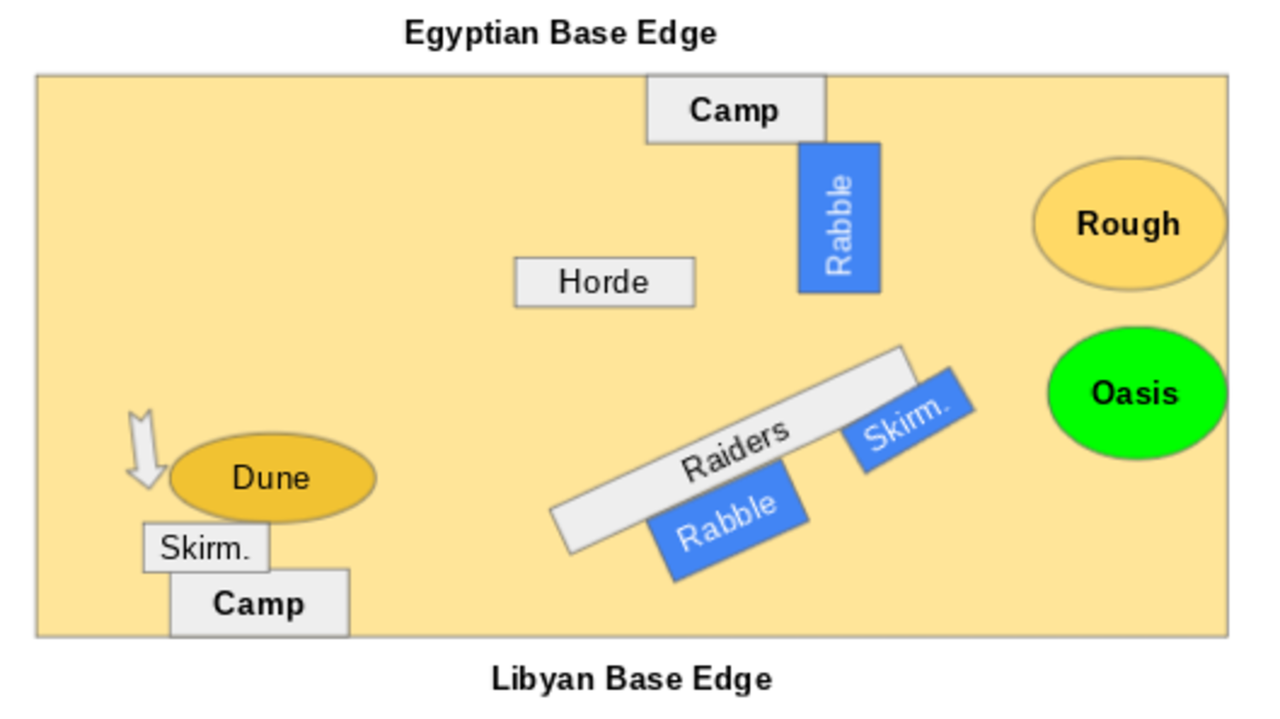
The Conclusion.
The issue hung in the balance, with both sides within a few points of victory. The issue was decided in the camps. The Libyan Rabble failed to take the enemy's camp. Soon after, the Egyptian raid on the camp finally went through. The loss of the Libyan camp ended the game with a narrow Egyptian victory; 16-12.
The Libyan forces were nineteen Rabble tribesmen, with two Skirmishers and a Warband general. They also had the Pack Trains battle card. I commanded the Libyans.
The Egyptian forces were an Elite infantry general (in this case the Pharaoh himself wearing the blue war crown), six units of menfat Raiders, three Hordes of local troops, four Bow levy, and two Skirmishers. My son commanded the Egyptians.

The Battlefield.
The terrain was Dry with three features - a Dune, some Rough, and an Oasis. These were all towards the edges of the board and played little role in the battle.

Deployment.
The Libyans had the option for a flank march, which would consist of eight stands of Rabble. The rest of the Libyan troops set up in a deep mass in the center. The Libyan plan was to try for the Egyptian camp with the flank march while avoiding defeat in the center.
The Egyptian plan was to strike the Libyan main body with the Raiders and Horde. Skirmishers would be sent to raid the Libyan camp. The Bow Levy would hold off the flank march.

Opening Moves.
The Egyptians moved first and the Skirmishers moved rapidly towards the dune in front of the Libyan camp. The main body advanced slowly to keep pace with the mass of conscripts attached behind their right flank.
This presented a dilemma for the Libyans. Should the flank march continue as planned, or come in near the Libyan camp to counter the Skirmishers? The Libyans decided to continue with the plan, counting on the fact the Egyptian Skirmishers were going to be far from the main battle where the Egyptians would be fully engaged.

The Battle.
The Egyptian Raiders continued to advance steadily, still hampered by the slow-moving Horde. The Libyan flank march was the main effort and moved quickly. Most of Pharaoh’s focus (command points) was on moving the Bow Levy and some Raiders to counter the flanking Libyans. The Egyptian Skirmishers therefore faltered in their mission, far from Pharaoh’s eye.
The Libyan flank march destroyed the Egyptian Bow levy (and the stand of Raiders sent to support them) then turned their attention to the camp.
The Libyan main body slowly wheeled, bringing their right flank closer to their flank marchers. The Libyan skirmishers went forward to support them by drawing off some of the enemy standing in their way.
Meanwhile, the Raiders abandoned the Horde and moved forward rapidly. The Raiders, along with the Pharaoh (Elite Foot General), made contact with the Libyan main body and began scattering the tribesmen.
The Horde played no further part in the battle.

The Conclusion.
The issue hung in the balance, with both sides within a few points of victory. The issue was decided in the camps. The Libyan Rabble failed to take the enemy's camp. Soon after, the Egyptian raid on the camp finally went through. The loss of the Libyan camp ended the game with a narrow Egyptian victory; 16-12.
